Simeon Allmendinger
Human Preferences in Large Language Model Latent Space: A Technical Analysis on the Reliability of Synthetic Data in Voting Outcome Prediction
Feb 22, 2025Abstract:Generative AI (GenAI) is increasingly used in survey contexts to simulate human preferences. While many research endeavors evaluate the quality of synthetic GenAI data by comparing model-generated responses to gold-standard survey results, fundamental questions about the validity and reliability of using LLMs as substitutes for human respondents remain. Our study provides a technical analysis of how demographic attributes and prompt variations influence latent opinion mappings in large language models (LLMs) and evaluates their suitability for survey-based predictions. Using 14 different models, we find that LLM-generated data fails to replicate the variance observed in real-world human responses, particularly across demographic subgroups. In the political space, persona-to-party mappings exhibit limited differentiation, resulting in synthetic data that lacks the nuanced distribution of opinions found in survey data. Moreover, we show that prompt sensitivity can significantly alter outputs for some models, further undermining the stability and predictiveness of LLM-based simulations. As a key contribution, we adapt a probe-based methodology that reveals how LLMs encode political affiliations in their latent space, exposing the systematic distortions introduced by these models. Our findings highlight critical limitations in AI-generated survey data, urging caution in its use for public opinion research, social science experimentation, and computational behavioral modeling.
CollaFuse: Collaborative Diffusion Models
Jun 20, 2024Abstract:In the landscape of generative artificial intelligence, diffusion-based models have emerged as a promising method for generating synthetic images. However, the application of diffusion models poses numerous challenges, particularly concerning data availability, computational requirements, and privacy. Traditional approaches to address these shortcomings, like federated learning, often impose significant computational burdens on individual clients, especially those with constrained resources. In response to these challenges, we introduce a novel approach for distributed collaborative diffusion models inspired by split learning. Our approach facilitates collaborative training of diffusion models while alleviating client computational burdens during image synthesis. This reduced computational burden is achieved by retaining data and computationally inexpensive processes locally at each client while outsourcing the computationally expensive processes to shared, more efficient server resources. Through experiments on the common CelebA dataset, our approach demonstrates enhanced privacy by reducing the necessity for sharing raw data. These capabilities hold significant potential across various application areas, including the design of edge computing solutions. Thus, our work advances distributed machine learning by contributing to the evolution of collaborative diffusion models.
CollaFuse: Navigating Limited Resources and Privacy in Collaborative Generative AI
Feb 29, 2024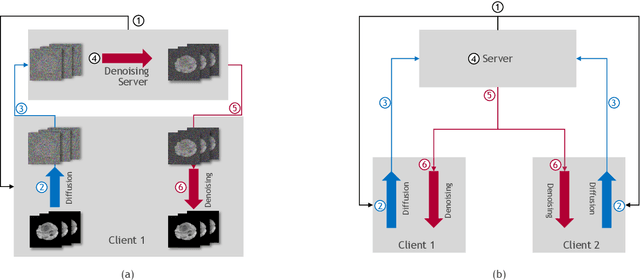

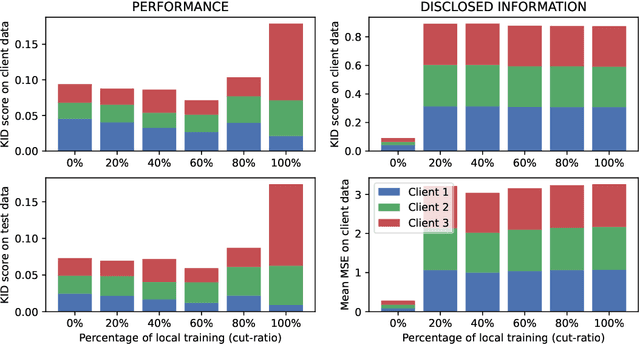
Abstract:In the landscape of generative artificial intelligence, diffusion-based models present challenges for socio-technical systems in data requirements and privacy. Traditional approaches like federated learning distribute the learning process but strain individual clients, especially with constrained resources (e.g., edge devices). In response to these challenges, we introduce CollaFuse, a novel framework inspired by split learning. Tailored for efficient and collaborative use of denoising diffusion probabilistic models, CollaFuse enables shared server training and inference, alleviating client computational burdens. This is achieved by retaining data and computationally inexpensive GPU processes locally at each client while outsourcing the computationally expensive processes to the shared server. Demonstrated in a healthcare context, CollaFuse enhances privacy by highly reducing the need for sensitive information sharing. These capabilities hold the potential to impact various application areas, such as the design of edge computing solutions, healthcare research, or autonomous driving. In essence, our work advances distributed machine learning, shaping the future of collaborative GenAI networks.
Navigating the Synthetic Realm: Harnessing Diffusion-based Models for Laparoscopic Text-to-Image Generation
Dec 05, 2023Abstract:Recent advances in synthetic imaging open up opportunities for obtaining additional data in the field of surgical imaging. This data can provide reliable supplements supporting surgical applications and decision-making through computer vision. Particularly the field of image-guided surgery, such as laparoscopic and robotic-assisted surgery, benefits strongly from synthetic image datasets and virtual surgical training methods. Our study presents an intuitive approach for generating synthetic laparoscopic images from short text prompts using diffusion-based generative models. We demonstrate the usage of state-of-the-art text-to-image architectures in the context of laparoscopic imaging with regard to the surgical removal of the gallbladder as an example. Results on fidelity and diversity demonstrate that diffusion-based models can acquire knowledge about the style and semantics in the field of image-guided surgery. A validation study with a human assessment survey underlines the realistic nature of our synthetic data, as medical personnel detects actual images in a pool with generated images causing a false-positive rate of 66%. In addition, the investigation of a state-of-the-art machine learning model to recognize surgical actions indicates enhanced results when trained with additional generated images of up to 5.20%. Overall, the achieved image quality contributes to the usage of computer-generated images in surgical applications and enhances its path to maturity.
Redefining the Laparoscopic Spatial Sense: AI-based Intra- and Postoperative Measurement from Stereoimages
Nov 16, 2023Abstract:A significant challenge in image-guided surgery is the accurate measurement task of relevant structures such as vessel segments, resection margins, or bowel lengths. While this task is an essential component of many surgeries, it involves substantial human effort and is prone to inaccuracies. In this paper, we develop a novel human-AI-based method for laparoscopic measurements utilizing stereo vision that has been guided by practicing surgeons. Based on a holistic qualitative requirements analysis, this work proposes a comprehensive measurement method, which comprises state-of-the-art machine learning architectures, such as RAFT-Stereo and YOLOv8. The developed method is assessed in various realistic experimental evaluation environments. Our results outline the potential of our method achieving high accuracies in distance measurements with errors below 1 mm. Furthermore, on-surface measurements demonstrate robustness when applied in challenging environments with textureless regions. Overall, by addressing the inherent challenges of image-guided surgery, we lay the foundation for a more robust and accurate solution for intra- and postoperative measurements, enabling more precise, safe, and efficient surgical procedures.
SurgT challenge: Benchmark of Soft-Tissue Trackers for Robotic Surgery
Feb 28, 2023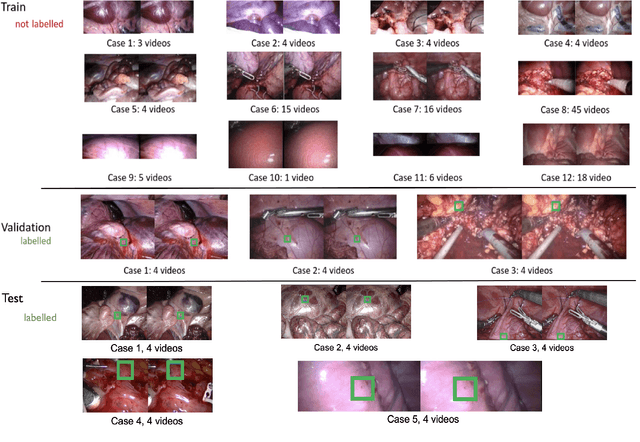
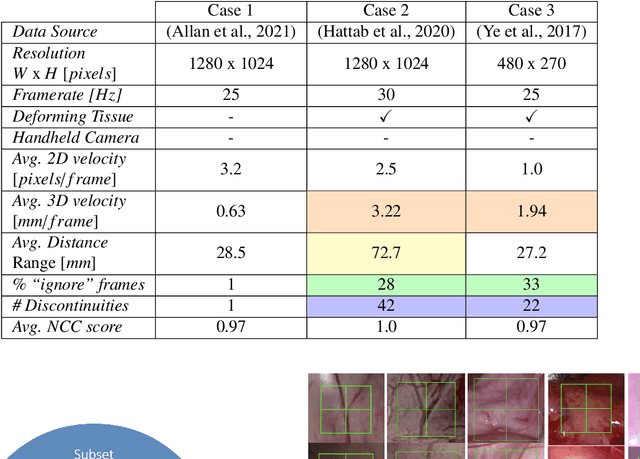
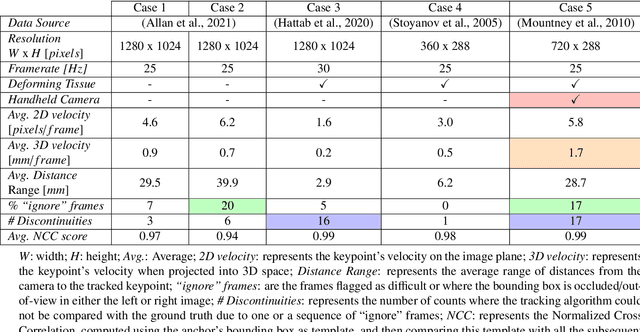
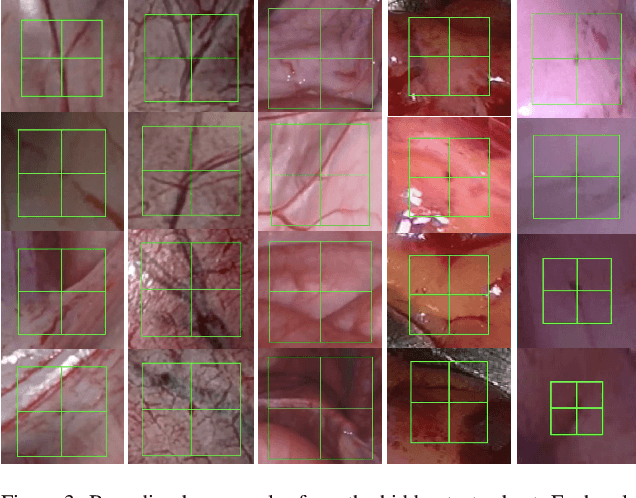
Abstract:This paper introduces the "SurgT: Surgical Tracking" challenge which was organised in conjunction with the 25th International Conference on Medical Image Computing and Computer-Assisted Intervention (MICCAI 2022). There were two purposes for the creation of this challenge: (1) the establishment of the first standardised benchmark for the research community to assess soft-tissue trackers; and (2) to encourage the development of unsupervised deep learning methods, given the lack of annotated data in surgery. A dataset of 157 stereo endoscopic videos from 20 clinical cases, along with stereo camera calibration parameters, have been provided. The participants were tasked with the development of algorithms to track a bounding box on stereo endoscopic videos. At the end of the challenge, the developed methods were assessed on a previously hidden test subset. This assessment uses benchmarking metrics that were purposely developed for this challenge and are now available online. The teams were ranked according to their Expected Average Overlap (EAO) score, which is a weighted average of the Intersection over Union (IoU) scores. The performance evaluation study verifies the efficacy of unsupervised deep learning algorithms in tracking soft-tissue. The best-performing method achieved an EAO score of 0.583 in the test subset. The dataset and benchmarking tool created for this challenge have been made publicly available. This challenge is expected to contribute to the development of autonomous robotic surgery and other digital surgical technologies.
 Add to Chrome
Add to Chrome Add to Firefox
Add to Firefox Add to Edge
Add to Edge